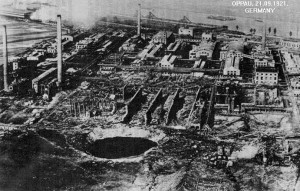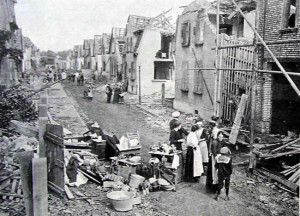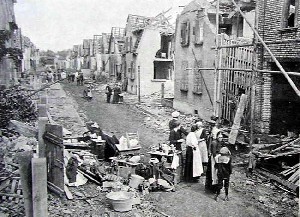At a chemical plant, an explosion destroyed a building storing 4,500 tonnes of a 50-50 composition of ammonium sulphate-nitrate, forming a crater 90 m wide, 125 m long and 20 m deep. Shortly thereafter, a series of fires broke out on the facilities, caused by a domino effect, amidst other explosions of lesser intensity. Heard more than 275 km away, the detonation created panic among the local population. A dark green cloud blanketed the sky over the region, and the telegraph and telecommunications infrastructure was destroyed. The extent of damage reached several tens of km from the accident site.
The result of this disaster was dramatic: 561 dead, 1,952 injured and over 7,500 left homeless. Nearly 80% of the buildings in the city of Oppau were levelled; considerable destruction was also observed in the towns of Ludwigschafen and Mannheim. In Heidelberg, about 30 km from Oppau, traffic was prohibited due to the large-scale presence of glass debris on road pavements. The magnitude of property damage and great numbers of victims complicated the task of emergency services. During these troubled times, politically, socially and economically speaking, it would take 3 years to remove all remnants of the accident.
The difficult investigation subsequently launched lasted more than 2 years. A report published in 1925 ultimately established that the accident occurred following a controlled blast carried out in the ammonium sulphate-nitrate stockpile for the purpose of disaggregating fertilisers clumped into a mass (a hygroscopic mix). Just a few months before the explosion, the manufacturing process had undergone modification in order to yield dryer fertilisers (2% humidity instead of 3%-4%), with a lower apparent nitrate density, yet making the final product more explosive. Moreover, the composition of the 4,500-tonne pile of ammonium sulphate-nitrate mix was likely to have been quite heterogeneous, with some zones containing a higher concentration of ammonium nitrate. The explosiveness of such a mix actually increases rather considerably should the proportion of ammonium nitrate rise from 50% to 60%. So when the blast was detonated, an enriched ammonium nitrate mix could ignite, causing the neighbouring portions of mix with a 50/50 split to explode; the detonation did not immediately spread to the entire stockpile, limiting the explosion to just 10% of the total mass (i.e. higher-density zones were spared).
During preliminary testing conducted in 1919 before production start-up, the operator had concluded that mixes of ammonium sulphate / nitrate at concentrations of less than 60% ammonium nitrate were non-explosive. These fertilisers were subsequently treated as a non-hazardous material. When the industrial process was modified in 1921, no additional tests were performed on the resultant mix. This accident highlights that a modification with apparently minor consequences on the end product properties can indeed substantially increase sensitivity to tri
Download the detailed report in .pdf format (176 Kb)







